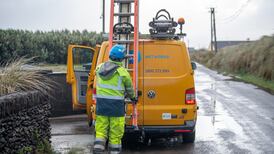The ESB was established almost a century ago, in 1927. For more than 70 years it was responsible for all aspects of the electricity system. In the early 2000s the potentially competitive elements of the business, such as generation and supplying consumers, were opened up to competition.
However, the monopoly elements, in particular the wires, have remained in the ownership of the ESB.
Responsibility for managing the electricity grid was given to a new State-owned company, EirGrid.
Since the beginning, ESB has operated as a commercial body, funding its activities through electricity bills. This makes it financially independent of its owner, the State.
It pays a dividend of about 5 per cent on the government’s investment, but most of the profits are reinvested. Even after the economic and financial collapse in 2008, ESB continued to reinvest its profits, rather than increasing the State’s dividend.
Today, ESB’s assets amount to almost €20 billion, with the State’s equity in the company being around €6 billion.
By ploughing most of its profits back into the company, ESB has been able to fund the expansion of the electricity system from its own resources, in good economic times and in bad. As a result, the major investment programme of ESB has not, to date, required substantial further State funding.
Unusually
However, in the recent budget the Government announced that it would, unusually, inject €3.5 billion into ESB and EirGrid to allow them to undertake a further major programme of investment.
The expansion of generating capacity is expected to increase ESB’s profits, as it sells on more energy to consumers and businesses. As with its existing stake in the company, the State will receive a return on this new money.
Because this injection of funds is a financial investment, it is not classified as government borrowing. It will add to the State’s gross debt, but it will also add to the State’s financial assets, leaving net debt unchanged.
This equity injection into the sector is needed to support the very large investment programme, planned for the next five years, to accommodate the “greening” of the system. With planned new wind generation at sea, EirGrid is to develop the offshore grid.
Because EirGrid doesn’t have the internal resources to fund investments on this scale, it needs this equity injection.
However, it is not clear why EirGrid was given responsibility for this particular programme of work, given that it had never undertaken engineering work on this scale in the past. ESB, which has experience of managing major projects, and has the financial strength to undertake this work, would have been a better fit.
The ESB’s commercial mandate, and its income from user charges, has enabled it to remain financially independent of the vagaries of the State finances, with an investment programme that has underpinned Ireland’s economic and population growth.
However, the political furore on water charges has meant that Irish Water/Uisce Éireann was never put on a similar footing, nor able to fund itself through charging users.
Given that Uisce Éireann depends for most of its revenue on the annual budget, where there have been limited funds to spare, it has been seriously handicapped in planning and implementing an essential long-term investment programme. Such a programme is needed, both to tackle deficiencies in the current elderly water and sewerage infrastructure, and to cater for our expanding population.
Hampered
The result today is that investment in housing is hampered by the inadequate water and sewerage system. Our environment is also much the poorer, due to the company’s inability to invest at the pace needed to modernise ageing sewage plants and avoid discharges.
If the company had been properly capitalised from the outset, it could have developed and implemented the needed investment, largely from its own resources, and at lower cost to the exchequer. At the same time, poorer households could have been protected through income-related exemptions or a welfare subsidy, like the fuel allowance.
The argument that charges would have enabled Uisce Éireann to be privatised was a complete red herring – no Irish government, watching the disaster that has been the privatisation of British water infrastructure, was ever likely to go that route. A strong commercial State company, like the ESB, was the model proposed.
Irish households don’t pay water charges – unlike our EU neighbours. But many Irish households are suffering high rents and house prices, driven in part by our inadequate water and sewage infrastructure, and the knock-on impact of this deficit on housing supply.


















